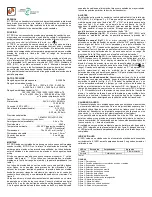
IST
Page 3
The Interface Solution Experts
Options
The following paragraphs outline the options avail-
able for the IST.
ATL Option
—
Low-impedance (200k) attenuated
input.
Must be specified with greater than 10V input
type.
EP Option
—
Externally-powered output loop.
Al-
lows the IST to accept operating power from its
output side.
RF Option
—
Radio Frequency/Electromagnetic In-
terference Protection.
Patented RF filter assembly
provides levels of protection based on SAMA stan-
dard 33.1. 50V/m –ABC - 0.5% of maximum span.
Consult the factory for RFI/EMI protection for dual
output models.
RFH Option
— Special version of the patented RF
filter assembly for 230 and 240Vac powered units,
provides levels of protection based on SAMA stan-
dard 33.1. 30V/m –ABC = ±0.1% of maximum span.
Consult factory for RFI/EMI protection for dual out-
put models.
TX Option
—
Transmitter Excitation.
Provides a
single, 2-wire transmitter excitation output of
24Vdc @ 25mA. Dual input units with –TX options
require –EP option (Option not available as a stan-
dard with 2X10-50MA input type, consult factory for
availability Option not available with voltage inputs).
IST Model Numbers
To order additional or replacement modules for your
system, refer to the Ordering Information table and
“build” a model number using the information in bold
text. Specify the following in order:
Product / Input / Output / Power / Option
[Housing]
For an IST with an input of 4-20mA and an output of
10-50mA using 117AC power and equipped with the
TX option in DIN housing, specify:
IST / 4-20mA / 10–50MA / 117AC / -TX [DIN]
Calibration
Prior to shipment, every IST is subjected to rigorous
testing by our team of skilled technicians. Every prod-
uct Moore Industries manufactures, sells and ser-
vices is guaranteed to meet the strict quality standards
that have become synonymous with our name.
Before placing your IST into service, a bench check
of basic operation is recommended to ensure that the
unit hasn’t sustained any damage during transit, and
to set zero and span for your application.
Every unit should be:
• Checked to verify that the appropriate IST model
has been ordered for the intended application.
• Connected in a calibration setup (described later
in this section) and checked for desired output.
• Adjusted for desired zero and span.
Power Selection – Internal Jumpers.
Most ISTs are set at the factory to the power level
used by the customer. To change the level, the units
side panel must be removed. If the value in the power
field of the model number is correct for your applica-
tion, skip the next section and procede with the Cali-
bration Procedures section. Otherwise, continue with
the following:
There are three jumpers on PC #2, inside the IST,
which control the unit’s input power level setting. Units
are capable of accepting power inputs of 117, 230, or
240 Vac. The customer can change the power setting
in the field as desired.
To access the jumpers, use a Phillips-head screw-
driver to remove the screws from the side panel with
the serial/model number label. Figure 1 shows the
printed circuit board and the location of the jumpers
for setting 117, 230, or 240 Vac.
There are no other internal adjustments or controls
in the IST. Re-install the side panel when jumper set-
ting is complete.
































